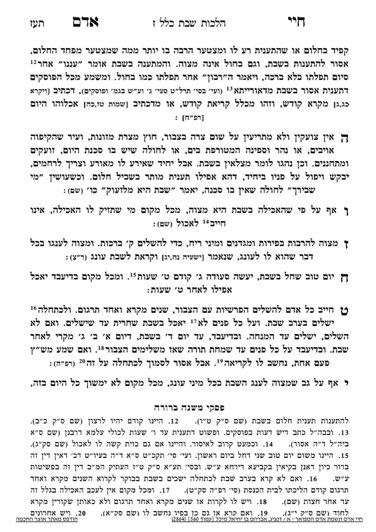The current series, which will cover seudos Shabbos and fasting on Shabbos, is available for sponsorship. Please contact Rabbi Reingold for more information.
We are continuing in siman 9, where the Chayei Adam discusses being maavir sedra. Regarding the earliest time to begin the new parsha, many people assume the earliest one may begin is Shabbos mincha time, when the tzibbur begins the new parsha. This is the opinion of the Mishnah Berurah, in siman 285:sk 7. However, the language of the Shulchan Aruch implies that the earliest one can begin is Sunday, because the entire Shabbos is connected to the previous week. Nevertheless, the Mishnah Berurah does hold one can start from Shabbos. The Chayei Adam follows the language of the Shulchan Aruch.
When a Yom Tov falls on Shabbos, the next parsha is read at the previous Shabbos mincha, but the entire parsha is not read until a week or two later. For example, in a non-leap year, Shmini is read at mincha of Shabbos Hagodol. If the first day of Pesach is Shabbos, the entire parsha will not be read until two weeks later. It is a machlokes when a person can begin shnayim mikra. The Knei Bosem, Rav Bransdorfer, holds that a person cannot begin until the week that Shmini will be read in Shul. However, Rav Wosner holds that a person can begin once the parsha is lained at Shabbos mincha, and spread it throughout the three weeks.
Regarding Vezos Habracha, according to Rav Wosner, a person can begin shnayim mikra from the moment the tzibbur finishes Haazinu. Rav Bransdorfer writes that Vezos Habracha is not tied to a Shabbos, but rather to the Yom Tov of Shmini Atzeres (or Simchas Torah in chutz laaretz). If so, in Eretz Yisroel, the zman only begins on the afternoon of Hoshana Rabba going into Shmini Atzeres, and in chutz laaretz, the zman begins on Shmini Atzeres, going into Simchas Torah.
The language of the Mishnah Berurah seems to support Rav Bransdorfer, as the Mishnah Berurah writes (sk 18) that one should read shnayim mikra for Vezos Habracha on Hoshana Rabba, and if they are in Eretz Yisroel, if they read it on Shmini Atzeres, it is fine as well. According to all opinions, once the tzibbur has begun Bereishis, they can no longer make it up. The minhag seems to follow the lenient opinion and begin once the tzibbur has read Haazinu.
Summary
- The earliest time to begin shnayim mikra is Shabbos mincha, but many hold to wait until the previous Shabbos is completely finished.
- When Yom Tov falls out over Shabbos such that there is no regular parshas hashavua, it is a machlokes whether one may begin shnayim mikra from the previous Shabbos mincha or must wait until the week the parsha will actually be read.
- Similarly, there is a machlokes whether Vezos Habracha can be read from Shabbos mincha of parshas Haazinu, or if one must wait until Hoshana Rabba. The minhag is to begin from Shabbos mincha of Haazinu.



